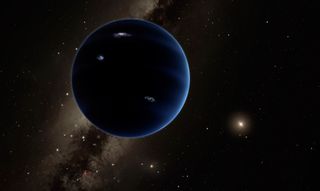Best Space Stories of the Week – Jan. 24, 2016

Astronomers have found evidence of a big, undiscovered "Planet Nine" far beyond Pluto, and a SpaceX rocket nearly landed soflty on a ship at sea after a successful satellite launch. Here are Space.com's top stories of the week.
A massive planet beyond Pluto?
The mythical "Planet X" may actually be real, and scientists are calling it "Planet Nine." Astronomers have found evidence for a planet 10 times more massive than Earth in the far outer solar system, orbiting about 20 times farther from the sun than distant Neptune does.[Full Story: 'Planet Nine' May Exist: New Evidence for Another World in Our Solar System]
Will astronomers be able to spot 'Planet Nine?'
If Planet Nine really exists, astronomers have a pretty decent chance of spotting it. Here's how. [Full Story: How Astronomers Could Actually See 'Planet Nine']
SpaceX nearly lands an orbital rocket at sea
SpaceX successfully launched a new satellite into orbit to map Earth's oceans on Jan. 17, but the spaceflight company's bold plan to land a rocket on a robotic ship at sea after the liftoff came up just short. [Full Story: SpaceX Narrowly Misses Rocket Landing at Sea After Launching Satellite]
Get the Space.com Newsletter
Breaking space news, the latest updates on rocket launches, skywatching events and more!
Five planets align in rare skywatching treat
For the first time in more than a decade, five planets will take center stage in the morning sky this week. Mercury, Venus, Mars, Jupiter and Saturn will be visible in the predawn hours starting on Jan. 20 and lasting through late February.[Full Story: Five Planet Conjunction to Dazzle Night Skies This Week]
Are all the aliens extinct?
It may be relatively easy for life to evolve on planets throughout the universe, but very hard for it to get any kind of a foothold, a new study suggests. This could be the answer, the study's authors say, to the famous Fermi Paradox, which in its simplest form asks, "Where is everybody?" [Full Story: Sorry, E.T.: The Aliens May All Be Dead]
Hunting alien life with a holographic microscope
Scientists have detected microbes in Greenland sea ice using a specially built digital holographic microscope, suggesting that the instrument could have similar success on icy moons in the outer solar system, if any of them harbor life. [Full Story: How Holograms Could Aid Alien Life Hunt]
First flowers grown in space?
"First ever flower grown in space makes its debut!" With that declaration, NASA astronaut Scott Kelly revealed to the world the bright orange zinnias that had blossomed on board the International Space Station on Jan. 16. But Kelly made a mistake: His zinnias were not actually the first flowers grown in space.[Full Story: First Flower Grown in Space (Or Not): Zinnia Blooms on Space Station]
New look at huge Pluto ice volcano
Pluto’s weirdly dynamic and "young" surface has just become even more intriguing with the release of a stunning color image of what is thought to be a huge ice volcano on the dwarf planet. [Full Story: A 'Wright Mons-ter': Pluto's Ice Volcano Is Huge]
Happy 10-year anniversary, New Horizons!
Tuesday (Jan. 19) marked the 10th anniversary of the launch of NASA's New Horizons spacecraft, which captured the first up-close looks at Pluto and its moons during a spectacular July 2015 flyby. [Full Story: New Horizons Launched for Pluto 10 Years Ago This Week]
NASA to start work on next big space telescope mission
Next month, NASA will begin work on its next major space observatory after the James Webb Space Telescope, which is finishing construction for launch in 2018. The new mission is called WFIRST (Wide Field Infrared Survey Telescope) and will investigate dark energy, exoplanets and galaxy formation. It is expected to fly in 2024. [Full Story: WFIRST: Work On NASA's 'Spy Telescope' Begins]
When will humanity make contact with advanced aliens?
Are intelligent aliens out there? If so, when will humanity make contact with them? Here's what some experts had to say. [Full Story: When Will We Make Contact with Intelligent Aliens?]
Do 'space noodles' swirl in the Milky Way?
Invisible structures shaped like noodles, lasagna sheets or hazelnuts could be floating around in our galaxy, radically challenging our understanding of the gas that makes up stars, researchers say. [Full Story: Invisible Space 'Noodles' May Lurk in the Milky Way]
Follow us @Spacedotcom, Facebook or Google+. Originally published on Space.com.
Join our Space Forums to keep talking space on the latest missions, night sky and more! And if you have a news tip, correction or comment, let us know at: community@space.com.

Space.com is the premier source of space exploration, innovation and astronomy news, chronicling (and celebrating) humanity's ongoing expansion across the final frontier. Originally founded in 1999, Space.com is, and always has been, the passion of writers and editors who are space fans and also trained journalists. Our current news team consists of Editor-in-Chief Tariq Malik; Editor Hanneke Weitering, Senior Space Writer Mike Wall; Senior Writer Meghan Bartels; Senior Writer Chelsea Gohd, Senior Writer Tereza Pultarova and Staff Writer Alexander Cox, focusing on e-commerce. Senior Producer Steve Spaleta oversees our space videos, with Diana Whitcroft as our Social Media Editor.
